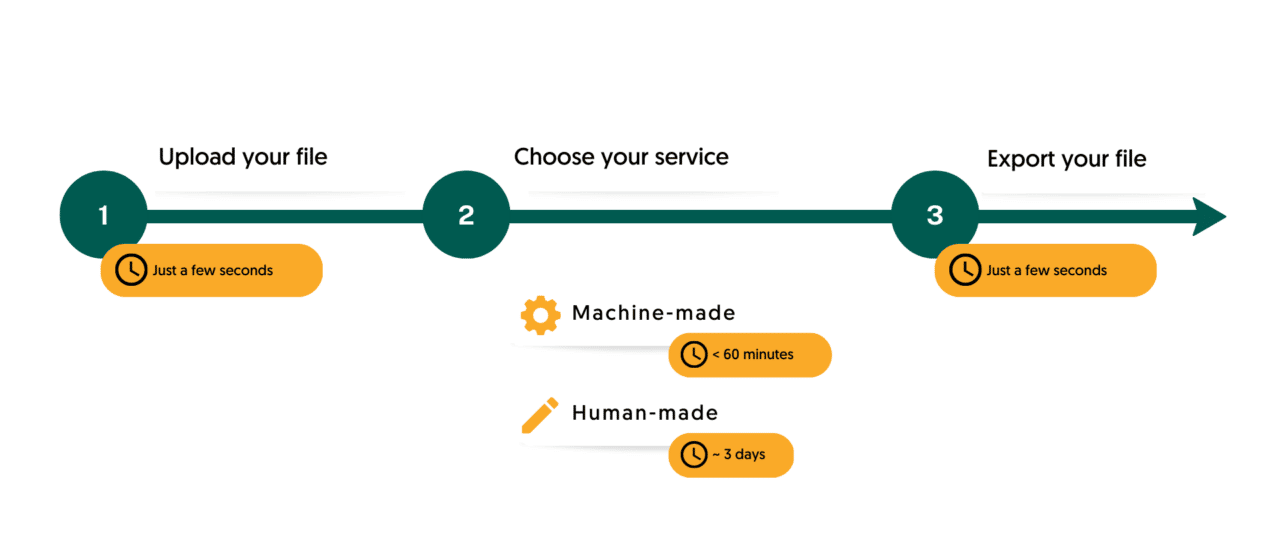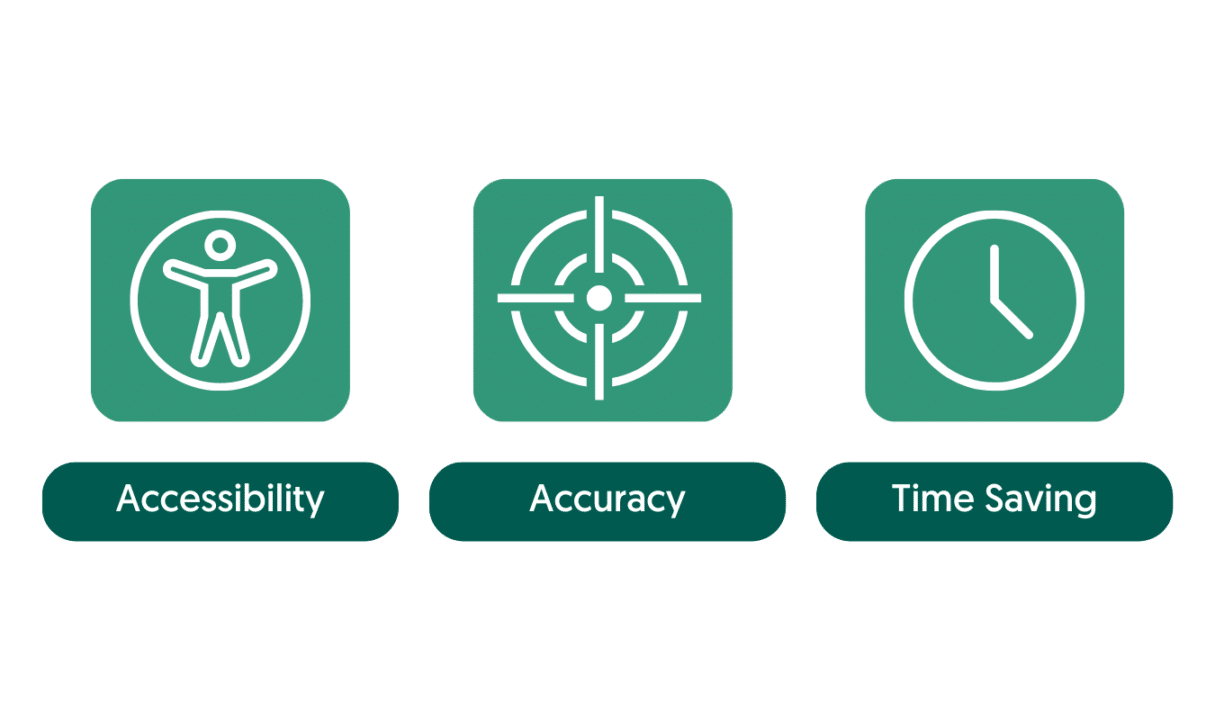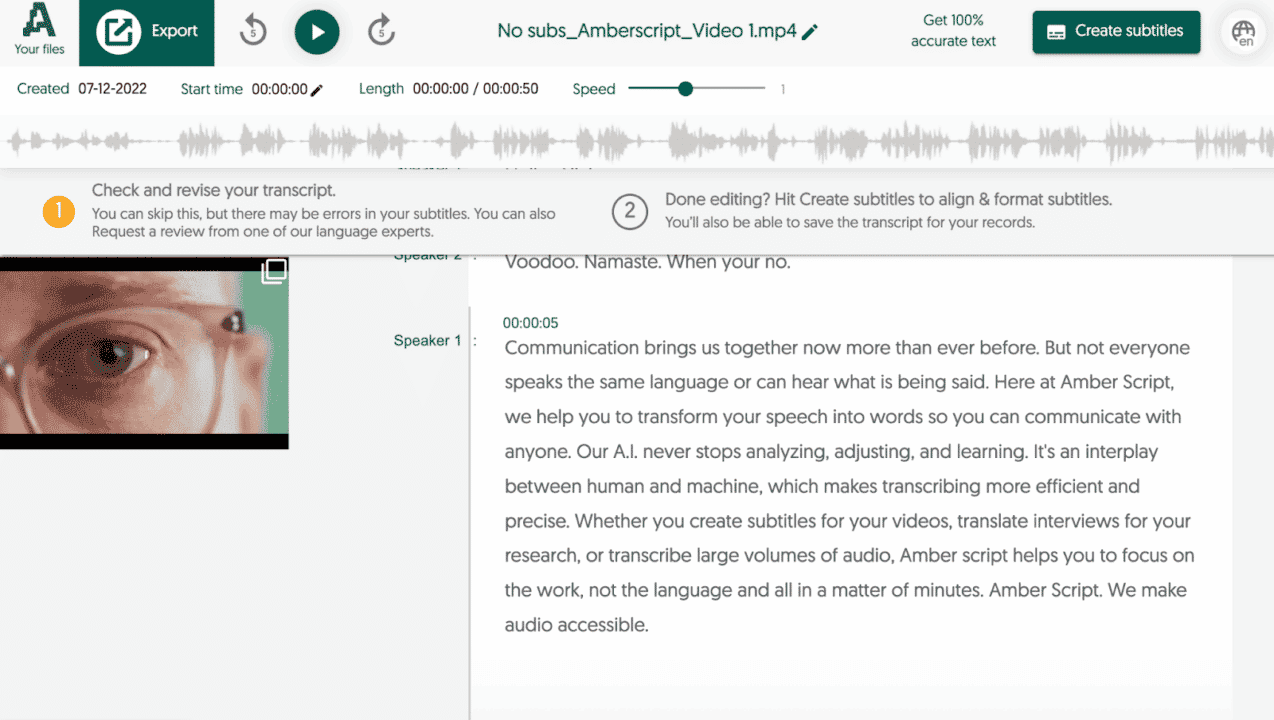From legal and medical to media and academia, transcription has become a vital tool for converting spoken language or audio into written form. It enhances accessibility for the hard of hearing, provides a written record of important conversations, and facilitates research analysis. In this guide, we’ll explore the many uses and benefits of transcription, giving you everything you need to know to get started.
Table of content
- What is ‘Transcription’?
- What types of transcription are there?
- The importance of transcriptions
- Use Cases for Transcription
- How long does it take to transcribe? And what does it cost?
- Transcription methods
- Transcription Technology
- Accuracy and Quality of Transcription
- Tips for an efficient and accurate transcription process
What is ‘Transcription’ and what exactly is audio transciption?
Transcribing or ‘transcription’ is a synonym for ‘writing out’ or ‘typing out’. It is the process of converting spoken language or recorded audio into written or digital text. The most common application of transcriptions is the transcription of audio and video files, by listening to an audio or video recording and transcribing or typing out the words spoken by the speaker(s).
Audio Transcription
In a nutshell, audio transcription is the conversion of the speech content of an audio file into written text, not video files. Often these audio files include; interviews, academic research, conversations, or even the recording of your father’s speech at your wedding.
Transcriptions can be done in three different ways. Either manually by yourself, manually by a professional transcriber, freelancer, or transcription agency, or automatically using speech recognition software.
Transcribe with Amberscript in 3 simple steps

Transcribing audio to text is important in various fields, including medical, legal, business, media and academic. It can help to improve accessibility, accuracy and comprehension of spoken content. Depending on what the transcription is to be used for, a different type of transcription can be applied.
What types of transcription are there?
There are 2 types of transcribing: verbatim and edited. Depending on the purpose of transcribing, one or the other is more suitable.
1. Clean read transcription
Clean read transcription, aims at the content of a conversation in a clearly legible form. Half sentences, aborted words, and interjections are ignored and the transcriptionist writes the conversation grammatically correct (as far as possible).
With an edited transcript, the content of a conversation is perfectly reproduced, while the way in which something is said is less important.
When is the clean read transcription used?
- For interviews that serve as a basis for articles or documentaries
- For qualitative research where the content of the conversation is in focus
- At meetings that have to be published
- Notes that you recorded just for yourself

2. Verbatim transcription
Literal transcription, also called verbatim, aims to record the way “how something is said”. During literal transcribing a letter-by-letter transcript is written out which the speakers follow as accurately and completely as possible.
This also means that interjections, repetitions, stutters, interrupting words, and colloquial language is literally typed out, such as:
| Interjections | Euhms and aahs |
| Repetitions | “I’m just saying, the region … the Brabant region uh, that uh, that’s the focus” |
| Stutters | “It’s mainly about the the the region in Brabant.” |
| Interrupted words | “We will be back to the municipal meeting next wee-, what is the name? City council meeting together” |
| Colloquial language | “Here we are all together” |
When is it important to transcribe literally?
- In qualitative research where the intonation of respondents is important
- In research where the way in which something is said is crucial
- In psychological research
- In transcripts for legal purposes

Learn more about the difference between Verbatim and Clean read transcription.
The importance of transcriptions
Transcription is important for various reasons, including improving accessibility, accuracy, and time saving.

Accessibility
Transcription is a powerful tool that can break down barriers and make information accessible to all. For those who are deaf or hard of hearing, or non-native speakers, transcription can provide a written version of spoken content, allowing them to fully participate in discussions, debates, and entertainment. By converting audio and video content into text, transcription enables people with hearing impairments or language barriers to access valuable information and enjoy content that might otherwise be inaccessible. This not only improves accessibility, but also promotes inclusion and diversity, ensuring that everyone can benefit from the wealth of knowledge and entertainment available today.
Examples
Accessibility powered by transcription
-
Captions for videos
Transcripts are used to create subtitles. Adding captions to videos is a common way to improve accessibility. Captions provide a written version of the spoken words in the video, allowing people with hearing impairments to follow along with the content. Learn more about video subtitles here.
-
Transcripts for webinars and online courses
Providing transcripts for webinars and online courses can help make the content more accessible. Transcripts provide a written version of the spoken content, allowing people to read and understand the material even if they are unable to listen to the audio. Learn more about transcripts for webinars and online courses.
-
Transcripts for podcasts
Providing transcripts for podcasts is another way to improve accessibility. Transcripts provide a written version of the spoken content in the podcast, allowing people to read the content if they are unable to listen to the audio. Learn more about podcast transcription here.
Accuracy
In a world where communication is everything, transcription is the key to unlocking accurate understanding. By converting spoken language into written form, transcription can help avoid misunderstandings, clarify key points, and capture every detail with precision. Whether dealing with technical jargon or complex terminology, transcription ensures that the meaning is accurately conveyed, so that nothing is lost in translation. In fields such as legal, medical, and journalism, accuracy is paramount, and transcription provides a vital tool for record-keeping and reporting. With transcription, we can be confident that the truth is preserved, and that our understanding of the world is as clear and accurate as possible.
Examples
Unlocking accurate understanding
-
Transcribing legal proceedings
Transcribing court proceedings, depositions, and other legal conversations can help ensure that all details are captured accurately, which can be important for future reference or for use in legal cases. Learn more about legal transcription.
-
Transcribing medical reports
Transcribing medical reports, such as doctor-patient conversations, can help ensure that all details are captured accurately, which can be important for future reference and for providing continuity of care.
-
Transcribing interviews for journalism
Transcribing interviews can help avoid misunderstandings and clarify important points, ensuring that the final article is as accurate as possible. Learn more about the importance of transcriptions in journalism.
Time savings
By converting audio and video content into text, transcription allows us to read and review information more quickly than we could by listening to it. This is especially useful in academic and research settings, where sifting through hours of recorded material can be a daunting task. With transcription, researchers can easily scan through the text and extract relevant information, without wasting time listening to the entire recording. Transcription can also help people save time when taking notes during meetings, lectures, or interviews. By transcribing the conversation, they can focus on active listening and engaging in the discussion, while knowing that they have an accurate written record of everything that was said. Ultimately, transcription can help us be more productive, efficient, and effective in all areas of our lives.
Examples
Saving time with transcription
-
Transcribing meeting notes
In a business setting, transcribing meeting notes can save time by allowing participants to quickly review what was discussed and decided without having to listen to an entire recording. This can help ensure that everyone is on the same page and can prevent misunderstandings or mistakes.
-
Transcribing interviews for research
In academic or research settings, transcribing interviews can save time by allowing researchers to quickly locate relevant information without having to listen to the entire recording. This can be particularly useful when conducting research that involves a large number of interviews or when time is limited. Learn more about the use of transcriptions for research purposes.
-
Transcribing lectures for students
In educational settings, transcribing lectures can save time for students who may have difficulty keeping up with the spoken content. By providing a written transcript of the lecture, students can quickly review the material and locate important information without having to re-listen to the entire lecture. Learn more about how transcriptions and subtitles can enhance academic achievement.
Use Cases for Transcription
Transcription is used in various fields, including journalism, legal proceedings, medical documentation, market research, and academic research.
Market Research
Transcription is a powerful tool for businesses conducting market research. By transcribing focus group sessions and customer feedback, businesses gain a detailed record of customer opinions and feedback, helping them understand customer needs and preferences. Transcription also allows businesses to identify patterns and trends in customer feedback, making it easier to spot common issues and concerns. By analyzing transcribed customer feedback, businesses can respond to customer needs more effectively and develop targeted solutions that address specific issues. Ultimately, transcription is essential in helping businesses make data-driven decisions and improve their products or services. Learn more about how transcriptions can help you and your business here.
Legal Proceedings
In legal proceedings such as court hearings, depositions, and interviews, transcription is a crucial tool that helps ensure justice is served. Transcription creates an accurate record of events, providing lawyers, judges, and other legal professionals with an unambiguous reference for future use. The importance of accuracy in legal documentation cannot be overstated, as even the smallest detail can make a significant difference in the outcome of a case. With transcription, legal professionals can review exact statements made during proceedings, ensuring all details are captured accurately. Furthermore, transcription can also help legal teams prepare for future proceedings by analyzing previous testimony and identifying potential areas for further questioning. All in all, transcription is an essential tool for legal professionals, enabling them to conduct proceedings accurately and effectively, and ensuring that the principles of justice are upheld. Learn more about legal transcriptions here.
Academic Research
Transcription is a vital tool in academic research, and its uses go far beyond just interviews, lectures, and focus groups. For example, in linguistics research, transcription can help analyze speech patterns and identify unique linguistic features. In medical research, transcription can aid in analyzing patient interviews or medical history for research purposes. Additionally, transcribing research team meetings can provide researchers with a clear and accurate record of discussions, making it easier to recall decisions or ideas generated during meetings. By transcribing their research, academics can quickly and easily analyze data, identify patterns, and draw insights that may have been missed otherwise. This can help to streamline the research process, making it more efficient and effective. Ultimately, transcription plays a crucial role in the academic research process, providing a valuable resource for researchers to draw upon when conducting their work. Learn everything you need to know about interview transcription.
Other Industries
Transcription isn’t just for academics and legal professionals anymore! Industries like journalism, podcasting, and media production can also reap the benefits. With accurate transcriptions, journalists can quickly capture and record interviews, leading to more detailed and accurate articles. Podcasters can improve accessibility for their audience by providing show notes and transcripts, while media producers can use transcription to locate specific content and create closed captions and subtitles. And let’s not forget about search engine optimization! By providing written content for search engines to index, transcription can make your content more discoverable than ever before. So whether you’re a journalist, podcaster, or media producer, don’t underestimate the power of transcription!
How long does it take to transcribe? And what does it cost?
Transcribing is a process that requires a lot of concentration and time. So how much time should you allow for transcribing? This depends on the type of transcription you choose. Manually on your own, manually by a freelancer or a transcription agency, or automatically using automatic speech recognition. You can find an overview in the following table.
| Type | Time | Costs |
|---|---|---|
| Independent transcribing | 5-10 times the duration of your audio | 0 Euro |
| Freelancer or transcription company | 4-5 working days (with accuracy of 100%) | 1,90 – 5,00 Euro/minute |
| Automatic transcription software | 1-2 hours (with accuracy of up to 85%) | > 0.25 Euro/minute |
Transcription methods
You have four options for creating transcripts. Either you transcribe yourself, you outsource the transcription process to a professional agency or transcriber, or you use automatic transcription software that does the transcription for you. The question of whether you transcribe yourself or outsource the process is ultimately a matter of your available time, budget or other preferences.
The following table gives you a brief overview of the individual transcription methods and their features. This way you can decide in no time which type of transcription is best for you. All methods are subsequently described in more detail in this chapter.
| Feature | Independent transcription | Transcription agency | Transcription software | Freelancer |
|---|---|---|---|---|
| Speed | ~ 5-10 times the audio length | ~ 4-5 days | ~ 1-2 hours | ~ 1-5 days |
| Costs | ~ 0€ | > 1.50€/ Audiominute | > 0.25€/ Audiominute | > 1.90/ Audiominute |
| Accuracy | 100% | 100% | 85% | 100% |
| Security | high | mostly high | ~ medium | mostly low |
| Usability | 0% | 100% | 85% | 100% |
Transcription by an agency
There are agencies that specialise in transcribing interviews and group discussions. The advantages of this are:
| Speed | Agencies have more capacity and can deliver faster. |
| Reliability | Professional service providers such as Amberscript transcribe hundreds of hours per day – you can be sure that your transcript will be reliably delivered according to scientific transcription standards |
| Quality guarantee | Agencies follow the 4-eyes principle and can therefore guarantee high quality standards. |
| Data security | Make sure that the agency of your choice attaches importance to data protection and does not, for example, simply share your confidential recordings with unqualified third parties by e-mail. |
Agencies are experts who specialise in the secure and reliable transcription of interviews. So if you can afford the budget, it is advisable to have the tedious transcription done by specialists.
Transcription by freelance transcribers
In principle, it can be a good idea to bring in some extra help. If you do not want to hire a professional agency, you can still turn to freelance writers as another option. However, you need to pay attention to the following things:
| Qualifications | Frelance transcriptionists often have no experience with scientific transcription. As a result, you risk that your transcription does not meet the required quality standards |
| Reliability | Are you paying per minute? Then the transcriptionist will try to finish your transcript as quickly as possible. This can lead to poorer quality. Do you pay per working hour? Then there is a risk that you will end up paying more than you would with a professional agency. |
| Data protection | Freelancers often do not have a secure IT environment and therefore find it difficult to ensure that your data is processed confidentially and in accordance with the GDPR. Many freelancers use external transcription tools that may be located on unsecure servers. |
Transcribe content yourself
Transcribing audio or video content yourself takes a lot of time. Transcribing an hour of interview or group discussion usually takes a long time. However, transcribing yourself also has its advantages. For example, you can go deeper into your own research. Every time you listen to the audio recordings, you are already subconsciously doing a lot of your analysis. You understand exactly what the speakers mean and how something is said, saving valuable time in the analysis itself.

Transcribe with a transcription software
Process is made much easier with features such as shortcuts that automatically insert time codes or speakers’ names, as well as easy playback controls. One of the biggest advantages of transcription software is the option to choose between software with or without automatic speech recognition. With automatic speech recognition, the software will attempt to transcribe the audio file automatically, saving you time and effort, software without automatic speech recognition may provide better accuracy and allow for more customization during the transcription process.
Transcription Technology
Automatic Speech Recognition
From virtual assistants to call centers, Automatic Speech Recognition (ASR) is revolutionizing the way we transcribe audio. ASR uses advanced algorithms and AI to break down speech patterns into smaller units, allowing it to transcribe spoken language quickly and accurately. With lightning-fast transcription speed and lower costs compared to human transcription services, ASR is becoming an attractive option for various industries.
Its ability to transcribe large volumes of content quickly and efficiently allows businesses that need to transcribe vast amounts of audio and video content regularly, to save both time and money compared to hiring human transcribers. Additionally, ASR can help improve accessibility for those with hearing impairments, as it can provide captions and transcripts for audio and video content.
Despite its many advantages, ASR does have some limitations to consider. Its accuracy can suffer when it comes to non-standard accents or noisy environments. Imagine a news report on a crowded street with honking cars in the background, ASR may struggle to pick up every word when transcribing the audio of that news report. Moreover, errors can occur when identifying specific words or phrases, which can lead to inaccuracies in the final transcript.
However, as technology continues to advance, these limitations are gradually being overcome. Overall, ASR is a powerful tool that has transformed the transcription industry, making it more accessible, cost-effective, and efficient for businesses and individuals alike. However, it is important to be mindful of its limitations and use it in conjunction with human transcription services when accuracy is critical.
| Advantages | Disadvantages |
|---|---|
| Speed: ASR can transcribe audio in real-time, allowing for fast and efficient transcription of spoken content. | Accuracy: ASR can struggle with understanding accents, background noise, and speech patterns that deviate from the norm, leading to errors and inaccuracies in the final transcript. |
| Cost-effective: ASR can be more cost-effective than hiring human transcribers, as it requires less manual labor. | Contextual understanding: ASR may not always accurately capture the context of spoken content, leading to misinterpretation of certain phrases or meanings. |
| Scalability: ASR can easily handle large volumes of audio content, making it ideal for businesses and organizations that need to transcribe large amounts of audio data. | Editing: ASR-generated transcripts may require more editing and proofreading than those generated by human transcribers to ensure accuracy and clarity. |
| Automation: ASR can automate the transcription process, freeing up time for human transcribers to focus on other tasks. |
Natural Language Processing
Natural Language Processing (NLP) is a subfield of artificial intelligence that focuses on the interaction between computers and human language. It’s used to improve the accuracy of transcription by helping the computer recognize the nuances of human language, such as grammar, syntax, and context. NLP uses techniques such as language modeling, which helps predict the most likely word or phrase based on the surrounding words, and named entity recognition, which identifies and categorizes proper nouns like names of people, places, and organizations. These techniques help improve the accuracy and efficiency of transcription by identifying and correcting errors in the transcription and making it easier for the computer to understand the spoken content.
How Amberscript Works
Amberscript is a transcription service that uses both ASR and NLP to deliver accurate and high-quality transcripts. ASR is used to automatically transcribe the spoken content, while NLP techniques are employed to improve the accuracy of the transcription.
Amberscript utilizes advanced language models that are specifically trained to recognize and transcribe different accents and languages accurately. This is accomplished through the use of custom models that are tailored to the specific needs of each client. The custom models help to improve the accuracy of the transcription by reducing errors caused by accents or technical jargon.
In addition to ASR and NLP, Amberscript also employs human editing to ensure the accuracy and quality of its transcriptions. The transcriptions are reviewed by professional editors who correct any errors and ensure that the final transcript is accurate and readable.
One unique feature of Amberscript is its ability to transcribe content in multiple languages, including languages with complex grammar and syntax. The service also offers a range of customizable options, such as formatting and time coding, to meet the specific needs of its clients.
Overall, Amberscript provides accurate and high-quality transcripts by combining the power of ASR and NLP with human intelligence and custom models. Its unique features and customizable options make it a valuable tool for businesses, researchers, and individuals seeking reliable transcription services.
Accuracy and Quality of Transcription
Challenges in achieving accurate transcriptions
Transcription can be a tricky business, with various challenges that can hinder accuracy. Background noise, accents, and technical terminology are just a few examples of obstacles that transcribers may face. But fear not! With some tips and best practices, these challenges can be overcome.
Background noise
Background noise can make it hard to hear the speakers or distinguish between different voices. To tackle this, it’s important to make sure that the audio recording is of good quality and to use noise-cancellation software or headphones to help reduce unwanted sounds. For example, a journalist conducting an interview in a busy coffee shop can use a directional microphone to pick up the interviewee’s voice and minimize background noise.
Strong accents
Strong accents can make certain words or phrases difficult to understand. A transcription service that offers language-specific models or employs transcribers who are familiar with the accent can be a big help. For instance, a podcaster interviewing a guest from another country with a thick accent can use a transcription service that has expertise in that language or accent.
Technical terminology
Technical terminology can also be a headache for transcriptionists, particularly in fields such as law or medicine. Providing the transcriber with a list of technical terms or using a transcription service that offers custom models for specific industries can help ensure accuracy. For example, a lawyer dictating legal briefs can use a transcription service that specializes in legal transcription and has a team of legal experts who are familiar with legal terminology.
In conclusion, accurate transcription can be challenging, but with the right tools and strategies, it can be done effectively. By using noise-cancellation software, language-specific models, and custom models, transcriptionists and clients alike can overcome common challenges and achieve high-quality transcriptions.

How Amberscript ensures high-quality transcriptions
When it comes to delivering high-quality transcriptions, Amberscript doesn’t cut corners. The company employs a unique approach that combines advanced technology with human expertise, ensuring that its customers receive accurate and polished transcriptions every time.
Using state-of-the-art ASR and NLP algorithms, Amberscript can transcribe audio into text at lightning speed. But it doesn’t stop there. The company knows that language is complex and nuanced, and that technology alone can’t always capture all the subtleties of spoken words. That’s why it also employs a team of skilled language experts and proofreaders to review and refine the transcriptions, guaranteeing accuracy and quality.
Take the example of a medical conference, where doctors are discussing the latest breakthroughs in cancer treatment. The language used is highly technical, with a multitude of jargon and acronyms. ASR and NLP tools may struggle to accurately capture all of this specialized vocabulary, but with Amberscript’s professional transcribers, every term is carefully scrutinized and double-checked for accuracy.
With its focus on combining human and artificial intelligence, Amberscript not only delivers accurate and polished transcriptions, but also saves its customers time and effort. Instead of spending hours reviewing and correcting transcriptions, customers can simply rely on Amberscript’s team of experts to deliver high-quality results.
Amberscript’s transcription software is:
Edit your own text within minutes or leave the work to our experienced transcribers.
Our experienced transcribers & thorough quality controls ensure 100% accuracy of your transcriptions.
Thanks to a variety of integrations and API interfaces, you can fully automate your workflows.
Your data is in safe hands. We are GDPR compliant + ISO27001 & ISO9001 certified.
Tips for an efficient and accurate transcription process
Want accurate and high-quality transcriptions? The first step is ensuring you have high-quality audio recordings. Position your microphone correctly, adjust recording settings, and choose the right file format to capture crystal-clear audio. Don’t let background noise or low-quality equipment ruin your transcription!
- Use a quality microphone: The quality of the microphone can greatly impact the clarity of the audio. Invest in a good quality microphone that is suitable for the recording environment.
- Check the recording settings: Ensure that the recording settings are appropriate for the situation. This includes adjusting the levels, bit rate, and file format.
- Minimize background noise: Try to record in a quiet environment to minimize any background noise that could interfere with the recording.
- Place the microphone properly: Proper microphone placement is key to capturing clear audio. Ensure that the microphone is close to the speaker and positioned at a 45-degree angle.

Conclusion
In conclusion, transcriptions are an essential tool for improving accessibility, accuracy, and saving time in various fields. With the right tools and techniques, such as Amberscript’s advanced ASR and NLP technology combined with human language experts, accurate and high-quality transcriptions can be achieved. We hope the information in this guideline can help ensure your transcription process is efficient and accurate. Don’t let transcription challenges hold you back, trust Amberscript to provide top-notch quality transcriptions for all your needs.
Transcription technology has made significant progress lately, thanks to the advancements in ASR and NLP. This technology’s continuous evolution presents a vast potential for even more efficient, accurate, and accessible transcription services.
Amberscript is well-positioned to stay at the forefront of these developments. With a dedicated team of experts in the fields of ASR and NLP, Amberscript is constantly working to improve its technology and enhance the accuracy and quality of its transcriptions. The company places a strong emphasis on customer feedback and satisfaction, using this information to continually refine and improve its services.
Frequently asked questions
-
How do you keep my files secure and confidential?
Amberscript’s IT infrastructure is built on the server infrastructure of Amazon Web Services located in Frankfurt, Germany. All data that is processed by Amberscript will be stored and processed on highly secured servers with regular back-ups on the same infrastructure.
-
What is the price?
For our prices, please refer to our pricing page.
-
What is the turnaround time?
Our state-of-the-art speech AI delivers results in less than an hour (depending on the size of the file, it can take only takes a few minutes). Just upload your audio into our system and we will notify you as soon as the file is ready! if you would like to learn about turnaround times for our manual subtitling services, click here.
-
Are you ISO27001 certified or do you have any other ISO certifications?
Amberscript’s IT infrastructure is built on data-servers provided by Google Cloud Platform, which are certified to the highest standards (including ISO27001). Amberscript as a company is also ISO27001 certified and has relevant processes in place to assure quality management and integrity of data.
-
Can I add a glossary with specific words to the transcription job?
Yes, we also offer specialized transcription, which can include jargon or specific vocabulary. To learn more about this or discuss specifics, please contact us.
-
Can I upload pre-recorded audio or video?
Yes, you can upload pre-recorded audio or video directly from your phone into the Amberscript app.
-
Can you also deliver transcriptions for other media formats?
We deliver data annotation for speech-to-text solutions. However, if you have a special request, please contact our sales team here.
-
Can you automatically detect the language of an audio file?
No, our standard API does not support language detection, however please reach out to our sales team here in order to find the perfect solution for your situation as we do have access to this technology.
-
Do you edit words (e.g. umm, uhh)?
We can, but this depends on the type of transcription you have ordered with us, “clean” or “verbatim”. To learn more about the difference between the two, read our blog.





